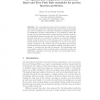Free Online Productivity Tools
i2Speak
i2Symbol
i2OCR
iTex2Img
iWeb2Print
iWeb2Shot
i2Type
iPdf2Split
iPdf2Merge
i2Bopomofo
i2Arabic
i2Style
i2Image
i2PDF
iLatex2Rtf
Sci2ools
MCS
2010
Springer
2010
Springer
An Experimental Comparison of Hierarchical Bayes and True Path Rule Ensembles for Protein Function Prediction
Abstract. The computational genome-wide annotation of gene functions requires the prediction of hierarchically structured functional classes and can be formalized as a multiclass, multilabel, multipath hierarchical classification problem, characterized by very unbalanced classes. We recently proposed two hierarchical protein function prediction methods: the Hierarchical Bayes (hbayes) and True Path Rule (tpr) ensemble methods, both able to reconcile the prediction of component classifiers trained locally at each term of the ontology and to control the overall precision-recall trade-off. In this contribution, we focus on the experimental comparison of the hbayes and tpr hierarchical gene function prediction methods and their cost-sensitive variants, using the model organism S. cerevisiae and the FunCat taxonomy. The results show that cost-sensitive variants of these methods achieve comparable results, and significantly outperform both flat and their non cost-sensitive hierarchical c...
| Added | 19 Jul 2010 |
| Updated | 19 Jul 2010 |
| Type | Conference |
| Year | 2010 |
| Where | MCS |
| Authors | Matteo Re, Giorgio Valentini |
Comments (0)

